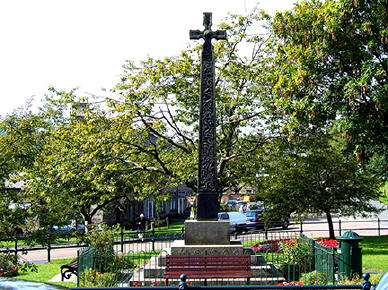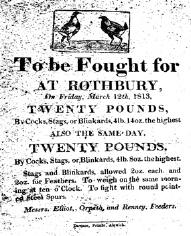Market Cross
The Market Cross, erected to the memory of Lord & Lady Armstrong, was unveiled on August 2nd 1902 by Sir Lowthian Bell, Lord Armstrong's oldest friend.
 The
inscription on the base reads:
The
inscription on the base reads:
|
"This
monument was erected in the year 1902, |
But whilst
the cross is
very attractive, hewn from
Cragside rock and carved
to an extremely high standard, the historic Market Cross was entirely different.
Erected in 1722 the it was a square building with a roof and four
open sides, designed to afford shelter to those attending the weekly market. This
type of building and its use can still be seen in other parts of Northumberland.
By 1827 the building, showed its age and was considered dangerous. The decision was taken to demolish it, much to the dismay of many villagers, one of whom penned a lament, which served to indicate an element of sadness at its loss, as well as registering some of the local village names.
|
"Ye
ancient inhabitants mourn for the loss |
Every last stone from the building was removed and Dippie Dixon reported in 1893 that the only remaining stone with an inscription was built into the gable end of a house in the Black Bull Yard with the name Archibold Douglas the only one still legible. The other men of note being Robert Snawdon and Robert Redhead.
It is worth noting here that, whilst many old inns have disappeared, directly opposite the cross is the Newcastle Hotel formerly known as the Black Bull. Still going strong the canopy over the front door is supported by the original ornate gas lamps that stood here. The third gas lamp stood at the corner and is now a pillar inside the bar. No doubt the council could not wait to erect a no parking sign in its place.
However The Rifleman, the Fox and Hounds, The Malt Shovel, and the Fighting Cocks are no longer with us whilst the Star is now a private house, painted white and situated at the west end of the village on the road to Thropton.
A local paper said this about the Rifleman in 1885:
"The old Rifleman Inn, a relic of the Rothbury of one hundred years ago, when the village was described as 'a poor town of two streets, which are not paved and the houses are mostly thatched ; they cover them with sods for warmth and with heath which will last thirty years' has at last succumbed to the improving spirit of these modern times. "The Rifleman" was an old thatched house that stood at the lower end of the village, which having been recently purchased by Mr A. Scott, butcher, is now in the process of being rebuilt."
Near the cross
at the east end of Market place, opposite the old Church
Gates stood
the pillory and the village stocks. The last person known to have been confined to
the stocks was Archie Deedles in 1820 for
drunk & disorderly conduct. Cock fighting continued
far longer in the village cock pit on Haa' Hill. At the west end of Market Place
stood the
Bull Ring.
known to have been confined to
the stocks was Archie Deedles in 1820 for
drunk & disorderly conduct. Cock fighting continued
far longer in the village cock pit on Haa' Hill. At the west end of Market Place
stood the
Bull Ring.
Today it is difficult to imagine
all this,
with the Armstrong cross surrounded by a quiet area of
lawn and enclosed by railings, (2002)
replacing those removed as part of the war effort and
the ugly concrete ones that followed them.
Just opposite the Cross stands the three armed Donkin's Lamp